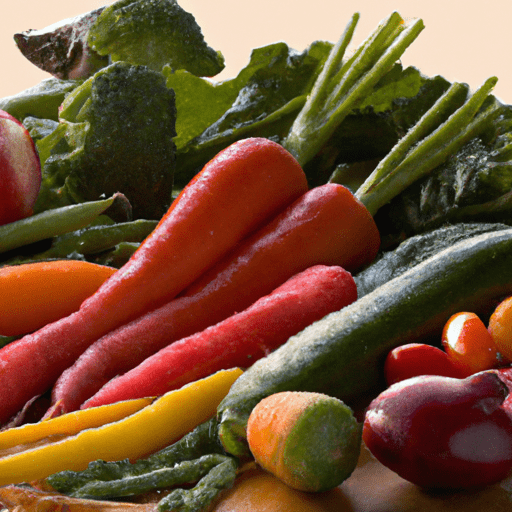The Versatile Vegetable Mix: A Burst of Flavor and Nutrition
When it comes to adding vibrant colors, distinct flavors, and a nutritious punch to your dishes, few ingredients can compare to the humble vegetable mix. This medley of various vegetables brings together an array of tastes and textures that elevate any recipe it graces. So if you’re looking to bring a burst of freshness and nourishment to your meals, read on to discover the wonders of the vegetable mix.
A Symphony of Tastes
The vegetable mix is a harmonious blend of different flavors, ranging from sweet to savory and mild to tangy. The medley often includes an assortment of colorful vegetables such as bell peppers, zucchini, carrots, onions, and broccoli. Each vegetable contributes its own distinct taste, creating a symphony of flavors that tantalize the taste buds.
The sweet crunch of bell peppers, the earthy sweetness of carrots, the subtle bite of onions, and the refreshing notes of zucchini all come together to deliver a delightful taste experience. Whether you’re stir-frying, roasting, or sautéing, the vegetable mix adds a vibrant and tantalizing element that enhances the overall dish.
Versatile in the Kitchen
One of the paramount advantages of the vegetable mix is its versatility in the kitchen. Its adaptable nature allows it to be incorporated into a variety of dishes, making it a true kitchen staple. From stir-fries and casseroles to salads and soups, the vegetable mix provides an instant flavor boost and adds a beautiful array of colors to any meal.
When sautéed with a drizzle of olive oil, a sprinkle of herbs, and a dash of seasoning, the vegetable mix becomes a fabulous side dish or a wholesome accompaniment to grilled meats or fish. It can also be the star of the show in vegetarian stir-fries or hearty pasta dishes.
Nutritional Powerhouse
Beyond its incredible taste and versatility, the vegetable mix is a nutritional powerhouse. Packed with essential vitamins, minerals, and dietary fiber, this colorful blend offers an assortment of health benefits. The combination of various vegetables ensures a diverse range of nutrients that support overall well-being.
Carrots, a common component of vegetable mix, are renowned for their high beta-carotene content, promoting eye health and a strong immune system. Bell peppers provide ample vitamin C while zucchini contributes a dose of potassium and folate. Broccoli, another common addition, is rich in antioxidants and offers a great source of fiber. By including the vegetable mix in your meals, you’re effortlessly incorporating a host of nutrients into your diet.
A Historical Blend
The vegetable mix, in various forms, has a long and fascinating history. While exact origins are difficult to pinpoint, the concept of combining different vegetables likely dates back centuries. In Mediterranean cuisine, dishes like ratatouille showcase the beauty and simplicity of blending complementary vegetables together. Similarly, Asian cuisines have long celebrated the art of stir-frying vibrant vegetable combinations to create harmonious and flavorful dishes.
Today, the vegetable mix continues to evolve and adapt to the tastes and culinary preferences of people worldwide. Its enduring popularity is a testament to its universal appeal and enduring health benefits.
In conclusion, the vegetable mix is an essential ingredient that adds a burst of flavor, versatility, and nutrition to countless dishes. Whether you’re a meat lover, vegetarian, or simply someone looking to elevate their cooking skills, experimenting with the vegetable mix is sure to lead to delightful culinary adventures. So why not embrace the colors and flavors of this wonderful blend and let it take your cooking to new heights?
Vegetable Mix
Origin: Vegetable mixes are combinations of various vegetables conveniently packaged together for consumption. The practice of mixing vegetables together originated as a way to diversify flavors, textures, and nutritional content in meals.
Common Uses: Vegetable mixes are widely used in cooking to add flavor, color, and nutrition to a variety of dishes. They are commonly used in stir-fries, pasta dishes, soups, stews, salads, and side dishes.
Nutritional Benefits: Vegetable mixes offer a wide range of nutritional benefits as they combine different vegetables with diverse nutrient profiles. They are excellent sources of vitamins, minerals, fiber, and antioxidants. The exact nutritional content may vary depending on the vegetables included in the mix.
Unique Properties: Vegetable mixes can be customized according to personal preference and culinary needs. They often include a combination of common vegetables such as carrots, peas, corn, green beans, and bell peppers, but can also include more unique options like broccoli, cauliflower, zucchini, or Brussels sprouts.
Historical Significance: The practice of combining different vegetables together in one dish has been part of culinary traditions across many cultures throughout history. The concept of mixed vegetables has been adapted and evolved over time, reflecting regional produce availability, culinary preferences, and dietary needs. The aim is often to create a harmonious blend of flavors, colors, and textures that complement each other.




Use the share button below if you liked it.
It makes me smile, when I see it.